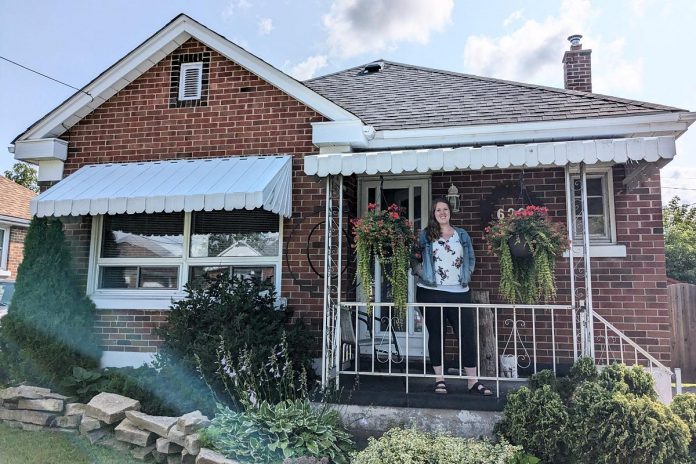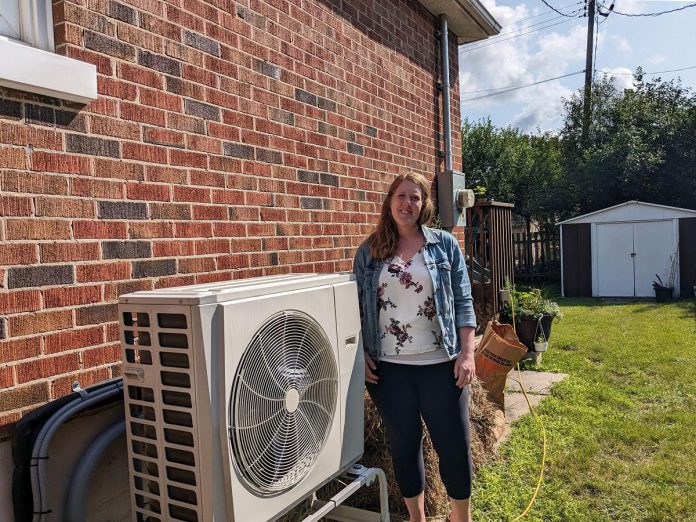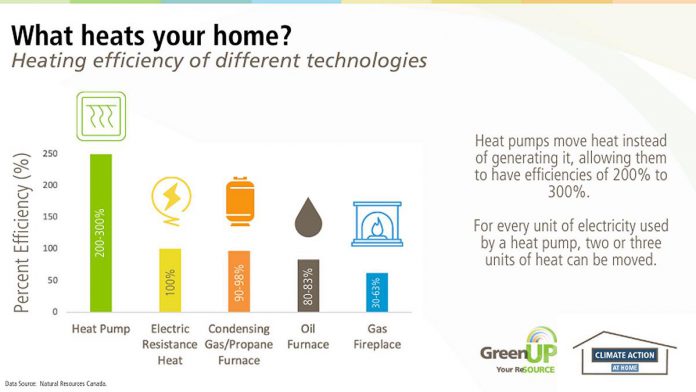
You’ve insulated your attic and your basement, upgraded your walls, and sealed up all the cracks and holes in your house. You’re ready for the next step in your deep retrofit journey: electrifying your home.
Deanna VandenBroek is a homeowner in Peterborough who started the deep retrofit journey recently.
VandenBroek moved into a 1940s bungalow in Peterborough with an oil furnace, a mostly uninsulated basement, and an attic with less than half of the insulation of today’s building code. By installing insulation in her basement and attic and replacing her oil furnace with a heat pump, VandenBroek reduced her greenhouse gas emissions by 90 per cent.
VandenBroek’s home never had a natural gas connection. By choosing a heat pump with an electric furnace as a secondary heat source, her home is now fully electrified, uses half the energy from before, and is ready for the future.
“On average, it’s cut my bills in half compared to having oil heating,” says Vandenbroek. “Heat pumps are a viable option that reduce your bills. And they are better for the environment … just trying to do my part.”
Using natural gas, propane, or oil to heat the house and water accounts for the vast majority of your home’s greenhouse gas emissions.

Because Ontario currently produces power using a fuel mix that includes nuclear, hydro, wind, and solar alongside natural gas, the electricity in our region emits far fewer greenhouse gas emissions than other home energy sources.
Emissions from electricity are six times less than natural gas, seven times less than propane, and nearly nine times less than oil, to produce the same amount of energy.
Home electrification can be phased in gradually. When the opportunity arises to replace a fossil fuel-burning appliance, it is a perfect time to choose electric. An added benefit of switching to electricity for heating and hot water is that it can produce heat significantly more efficiently, using heat pump technology.
Furnaces powered by fossil fuels generate heat by burning fuel. The most efficient are able to convert 98 per cent of fuel into heat energy. Older electric furnaces or baseboard heaters turn 100 per cent of the electricity into heat.
But since heat pumps move heat instead of generating it, this allows them to have efficiencies between 200 and 300 per cent. For every unit of electricity used by a heat pump, two or three units of heat can be moved.
Lou Arbour is a local homeowner who, since July of last year, has made some major strides towards home electrification, installing both an all-electric heat pump for home heating and cooling, and a heat pump hot water tank.

Heat pump hot water tanks are able to extract heat from the indoor air to heat water using less than half of the electricity of a traditional electric resistance tank.
While Arbour still has some gas appliances in his home, full electrification is not far off. His estimated annual energy use has fallen by more than half, and greenhouse gas emissions by 84 per cent.
“Next, I’m looking at solar panels to offset my increased electricity use, and an electric car,” says Arbour.
Apart from heat and hot water, the most common fuel-burning appliances in today’s homes are stoves, dryers, and fireplaces. Replacing fossil fuel burning appliances with electric ones, or minimizing their use as much as possible, are all steps towards reducing greenhouse gas emissions at home.
GreenUP provides resources and advice for homeowners looking to make energy upgrades in the home.
If you’re interested in replacing your furnace or hot water heater with a heat pump, rebates of up to $6,500 for heat pumps, and $1,300 for heat pump hot water tanks are available to Enbridge customers.

If you’re not an Enbridge customer, the maximum rebate is $5,000 for heat pumps, or $1,000 for heat pump hot water tanks. There is also a $40,000 interest-free loan available to support these and other upgrades.
An EnerGuide assessment is required to access incentives. Learn more at greenup.on.ca/home-energy.
This article is part of a series of GreenUP columns that focus on deep energy retrofits.


























